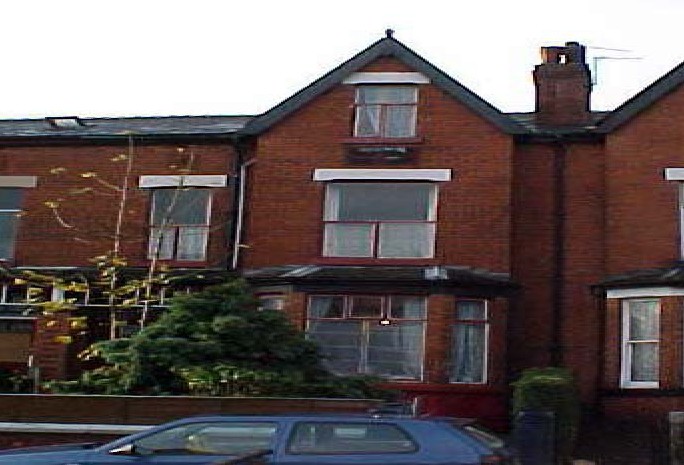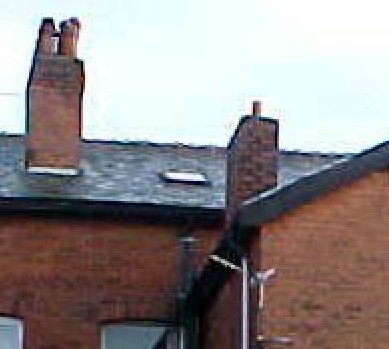

tank
dn
Kitchen
DESCRIPTION OF HAZARDS
Plan of flat
Dwelling: Pre 1920 non-self contained attic flat
Background: This three-storey late Victorian house in Inner London was converted in the 1950s to
provide a self contained flat on the ground floor and three non-self contained flats on the upper
floors. The one bedroomed attic flat shares a bathroom and a separate w.c. on the first floor with
the two flats on that level, but has its own small kitchen.
Insulation: Apart from 100mm of compacted insulation in the small, shallow void at the apex, the
attic flat has no thermal insulation, being located directly under the slate roof.
Ventilation: The full height living room window faces north and has one low opening casement.
The bedroom has a small openable roof light, while the kitchen is lit by fixed transparent tiles and
ventilated by a small extractor above the electric cooker that discharges into the roof void.
Heating:- The flat is heated by two old storage heaters, running on off-peak electricity, situated
under the ceiling eaves in the living room and bedroom.
LIST OF RELEVANT MATTERS
LIKELIHOOD & OUTCOMES
A
A
a
Thermal insulation
3
# Secondary hazards
b
Orientation of glazing
1
None
-
b
External shading & exposure
-
c
Heating controls
2
d
Ventilation provision
3
e
Ventilation control
-
Key
3
Seriously defective
1 Not satisfactory
f
Disrepair to ventilation
-
2
Defective
- Satisfactory/NA
HHSRS VERSION 2
SEPTEMBER 2004
HEAT
Persons aged 60 years or over
Excess cold; Falls from windows.
EXCESS
Vulnerable group
Related hazards
Front elevation
HHSRS VERSION 2
Multiple locations
Yes
No
Secondary hazards
Yes
No
Rear roof light
storage heater
roof light
Bedroom
void above
Living room
storage heater
Average likelihood, outcomes and HHSRS score for excessive cold for persons aged 60
years or more in pre 1920 HMOs, 1997-99.
HHSRS VERSION 2
SEPTEMBER 2004
HEALTH AND SAFETY RATING SYSTEM SCORES
Pre 1920 non s.c. flat
LIKELIHOOD
1 in
180
Low
High
Average: 60,000
Example
180
< 4200 2400 1300 750 420 240 130
75
42
24
13
7.5
4
2.5
1.5 >
Justification
OUTCOMES
Class I
Class II
Class III
Class IV
Justification
RATING
The lack of roof insulation and limited provision for ventilation, results in above average
indoor temperatures in all rooms in hot weather. Fortunately, the living room window
faces north (but presents a risk of falls if fully opened due to its low positioned opening
light). Conversely, the rooms quickly become cold at night, even in late Spring and early
Autumn, but using the old storage heaters to combat this results in further excess heat in
the flat when the next day is warm.
Low
High
Average: 31.0
31.6
< 0.05 0.15 0.3
0.7
1.5
3
7
15
26
38 >
Av: 8.0
10.0
< 0.05 0.15 0.3
0.7
1.5
3
7
15
26
38 >
Av: 25.0
21.5
< 0.05 0.15 0.3
0.7
1.5
3
7
15
26
38 >
Av: 36.0
36.9
< 0.05 0.15 0.3
0.7
1.5
3
7
15
26
38 >
Score
59
%
31.6
10.0
21.5
36.9
Although the risk of the dwelling reaching unhealthily high temperatures and the
consequent likelihood of harm is greater than average, there is nothing to suggest that
the spread of harms would be other than average.
Average: 5
Example
A B C D E F G H
I
J
Score
1848
RATING SCORES AFTER IMPROVEMENT
IMPROVE
Justification
NEW RATING
Av Nos:
Likelihood to
1 in 5,600
Outcomes to
31.6 10
21.5 36.9 %
There should be adequate thermal insulaion to the roof and larger opening double
glazed roof lights installed in the bedroom and kitchen. Other works required include
replacing the extractor fan in the kitchen and the old storage heaters with modern more
efficient and controllable units. This would increase the energy efficiency of the flat
substantially and thereby reduce the likelihood of both excessive heat and cold.
Av: 5
J
Improved
A B C D E F G H
I